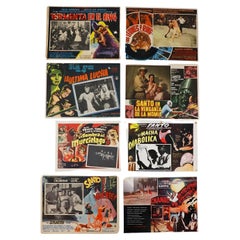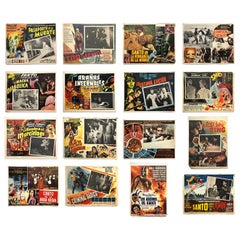Mil Mascaras
Fantastic Collection of 8 Original and Rare Mexican Wrestling Movie Posters
Located in Mexico City, CDMX
, with the most iconic Mexican wrestling icon Santo, Blue Demon Mil Mascaras.
Category
Vintage 1950s Mexican Mid-Century Modern Posters
Materials
Paper
$1,200 / set
H 16.93 in W 24.81 in D 1.19 in
Fantastic Collection of 8 Original and Rare Mexican Wrestling Movie Posters
Located in Mexico City, CDMX
, with the most iconic Mexican wrestling icon Santo, Blue Demon Mil Mascaras.
Category
Vintage 1950s Mexican Mid-Century Modern Posters
Materials
Paper
$1,200 / set
H 16.93 in W 24.81 in D 1.19 in
Recent Sales
Fantastic Set of 38 Vintage Mexican Wrestling Fighters Heads
Located in Mexico City, CDMX
hand painted includes El Santo, Blue Demon, Rayo de Jalisco, Mil Mascaras, Tinieblas, Octagon, Atlantis
Category
Vintage 1970s Mexican Folk Art Toys
Materials
Paint
Fantastic Collection of 16 Original and Rare Mexican Wrestling Movie Posters
Located in Mexico City, CDMX
, with the most iconic mexican wrestling icon Santo, Blue Demon Mil Mascaras.
Includes:
"Pasaporte
Category
Vintage 1950s Mexican Mid-Century Modern Posters
Materials
Paper
H 12.6 in W 16.54 in D 1.97 in
Original Vintage Mexican Wrestling Mask, 'Mil Mascaras'
Located in Mexico City, CDMX
We offer this original Vintage Mexican wrestling mask (Mil Mascaras).
Mil Máscaras (born Aarón
Category
Vintage 1970s Mexican Folk Art Masks
Materials
Fabric
Fantastic Collection of 6 Original and Rare Mexican Wrestling Movie Posters
Located in Mexico City, CDMX
, with the most iconic Mexican wrestling icon Santo, Blue Demon Mil Mascaras.
Category
Vintage 1950s Mexican Mid-Century Modern Posters
Materials
Papercord
H 16.93 in W 24.81 in D 1.19 in
Fantastic Set of 63 Vintage Mexican Wrestling Fighters Heads
Located in Mexico City, CDMX
resin and hand painted includes El Santo, Blue Demon, Mil Mascaras, Tinieblas among others, We can sell
Category
2010s Mexican Folk Art Toys
Materials
Paint, Resin
Fantastic Set of 67 Vintage Mexican Wrestling Fighters Heads
Located in Mexico City, CDMX
hand painted includes El Santo, Blue Demon, Rayo de Jalisco, Mil Mascaras, Los 5 brazos, Tinieblas y
Category
Vintage 1970s Mexican Folk Art Toys
Materials
Paint
Fantastic Collection of 8 Original and Rare Mexican Wrestling Movie Posters
Located in Mexico City, CDMX
, with the most iconic mexican wrestling icon Santo, Blue Demon Mil Mascaras.
Includes:
"Vuelven
Category
Vintage 1950s Mexican Mid-Century Modern Posters
Materials
Papercord
H 16.93 in W 24.81 in D 1.19 in
People Also Browsed
Antique Big Size Mexican Artisanal Sunburst Mirror
Located in Mexico City, CDMX
Circa 1950, we offer this Mexican artisanal sunburst mirror. Made in steel, presents some details and fantastic patina.
Category
Vintage 1970s Mexican Mid-Century Modern Sunburst Mirrors
Materials
Steel
Original Art Deco Credenza, Mexico, 1930s
Located in Mexico City, CDMX
Circa 1930, We offer this Original Mexican Art Deco Credenza. Made in solid pine wood. This piece represents the pure Mexican art deco of the 30's.
Category
Vintage 1930s Mexican Art Deco Credenzas
Materials
Pine
Get Updated with New Arrivals
Save "Mil Mascaras", and we’ll notify you when there are new listings in this category.



